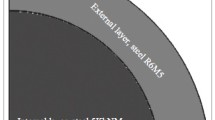Conclusions
-
1.
In selecting steels for wear resistant bimetals the possibility of joint heat treatment must be considered along with the operating characteristics.
-
2.
Heat treatment conditions for bimetals ensuring quenching of the wear resistant or cutting layer to the necessary hardness with retention of toughness and ductility of the base metal can be determined from conbined T-T-T diagrams with use of the compatibility criteria — the isothermal compatibility factor over 10 and the thermokinetic compatibility factor over 100.
-
3.
Using the combined diagrams and the compatibility criteria, one can determine scientifically the system of alloying for the components of selfsharpening, wear resistant, and tool bimetals used in the heat treated condition.
-
4.
In terms of thermal compatibility, the most suitable base metal for wear resistant and tool bimetals is carbon steel with ≥0.55% C. It is also possible to use steels alloyed with up to 1% Mn — of the 20–40 G or 20 KhG type.
Similar content being viewed by others
Literature Cited
M. B. Ioselevich, Sel'khoztekhnika, No. 2 (1940).
N. Mohsenin et al., Agricultural Engineering, No. 12 (1956).
I. P. Rabinovich et al., Sel'khozmashina, No. 11 (1957).
E. I. Astrov, Steel Production [in Russian], Supplement to Stal' (1963).
V. A. Rozhkov, Byulleten' TsIINChM, No. 8 (1948).
V. N. Tkachev, Wear and Durability of Working Tools in Soil Tilling Machines [in Russian], Mashinostroenie, Moscow (1964).
E. V. Zotova, Stal', No. 6 (1939).
E. I. Astrov et al., Steel Production [in Russian], Supplement to Stal' (1958).
E. I. Astrov and A. I. Chichkanov, in: Metal Science and Heat Treatment [in Russian], Gor'kovskoe Knizhnoe Izd. (1959).
A. Knaushner, Stal', No. 1 (1966).
N. F. Bokhovitinov, Metal Science and Heat Treatment [in Russian], Mashgiz, Moscow (1947).
E. Davenport, TASM,27, No. 3 (1939).
Atlas of Isothermal Transformation Diagrams of BCC Eutectoid Steels, London (1949).
V. S. Mes'kin, Fundamentals of Alloying Steel [in Russian], Metallurgiya, Moscow (1964).
A. Masi and P. Rovizza, Met. Italiana,60, No. 1 (1968).
N. N. Kachanov, Hardenability of Steel [in Russian], Metallurgiya, Moscow (1964).
A. A. Popov and A. E. Popova, Heat Treatment Handbook [in Russian], Mashgiz, Sverdlovsk (1961).
M. E. Blanter, Zavod. Lab., No. 5 (1949).
M. E. Blanter, Method of Investigating Metals and Treating Experimental Data [in Russian], Metallurgizdat, Moscow (1952).
M. E. Blanter, Phase Transformations during Heat Treatment of Steel [in Russian], Metallurgizdat, Moscow (1962).
Additional information
Central Scientific-Research Institute of Ferrous Metallurgy. Translated from Metallovedenie i Termicheskaya Obrabotka Metallov, No. 1, pp. 42–47, January, 1972.
Rights and permissions
About this article
Cite this article
Golovanenko, S.A. Heat treatment of wear resistant and tool bimetals. Met Sci Heat Treat 14, 43–47 (1972). https://doi.org/10.1007/BF00658346
Issue Date:
DOI: https://doi.org/10.1007/BF00658346




